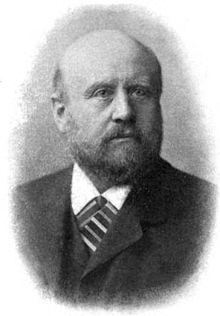Hugo von Seeliger
Hugo Johann Seeliger , since 1902 Hugo Hans Ritter von Seeliger (born September 23, 1849 in Biala , † December 2, 1924 in Munich ) was a German astronomer . He is considered one of the most important astronomers of his time.
Life
Seeliger was born in Biala in the Galician part of the Bielsko-Biala language island to a wealthy family, which enabled him to devote himself to science free of restrictions. He studied astronomy and mathematics in Heidelberg and Leipzig . During his studies in 1867 he became a member of the Frankonia Heidelberg fraternity . For a short time he was an assistant at the Leipzig observatory and in 1873 came to the observatory in Bonn as an observer, where he was assigned the observations of the meridian circle. In 1874 he led the German expedition to observe the passage of Venus III on Auckland Island.
Soon after his habilitation in 1877, he gave up his position and moved to Leipzig as a private scholar. From October 1, 1881 to September 1, 1882, Seeliger was director of the Gotha observatory for a short time . He was appointed professor, accepted an appointment at the University of Munich as director of the Bogenhausen observatory there and left Gotha again. Seeliger stayed in Munich until his death. In 1882 he was elected a member of the Leopoldina , in 1901 a corresponding member of the Göttingen Academy of Sciences , and in 1908 a member of the National Academy of Sciences .
Seeliger received numerous awards, including the Order of the Red Eagle III. Class 1896, title and rank of Royal Privy Councilor 1906, Commander's Cross 1st Class of the North Star Order in 1912, holder of the Order Pour le mérite for Sciences and Arts in 1915, and the Order of Merit of St. Michael II Class with Star in 1917. By the award The Knight's Cross of the Order of Merit of the Bavarian Crown , Seeliger was raised to the personal nobility in 1902 . In 1908 he received the commander of this order.
From April 1, 1919 to December 31, 1923, Seeliger was President of the Bavarian Academy of Sciences and a member of the Board of Trustees of the Physikalisch-Technische Reichsanstalt . He was also chairman of the Astronomical Society from 1896 to 1921 .
Seeliger's work is almost exclusively in the field of theory. Particularly noteworthy are his celestial mechanical investigations into the multiple star system Zeta Cancri and his lighting theory of Saturn's rings and zodiacal light on the basis of their dusty nature. Seeliger was also one of the co-founders of stellar statistics and the third director of the Bogenhausen observatory. Karl Schwarzschild is considered to be his most important student .
The lunar crater Seeliger and the asteroid (892) Seeligeria are named after him.
students
His students included:
- Julius Bauschinger , Ludwig Maximilians University of Munich, 1884
- Ernst Anding , Ludwig Maximilians University Munich, 1888
- Richard Schorr , Ludwig Maximilians University Munich, 1889
- Karl Oertel , Ludwig Maximilians University Munich, 1890
- Oskar Hecker , Ludwig Maximilians University Munich, 1891
- Adalbert Bock , Ludwig Maximilians University of Munich, 1892
- George W. Myers , Ludwig Maximilians University Munich, 1896
- Karl Schwarzschild , Ludwig Maximilians University, Munich 1897
- Lucian Grabowski , Ludwig Maximilians University Munich, 1900
- Gustav Herglotz , Ludwig Maximilians University Munich, 1900
- Emil Silbernagel , Ludwig Maximilians University, Munich, 1905
- Ernst Zapp , Ludwig Maximilians University Munich, 1907
- Kasimir Jantzen , Ludwig Maximilians University Munich, 1912
- Wilhelm Keil , Ludwig Maximilians University Munich, 1918
- Friedrich Burmeister , Ludwig Maximilians University Munich, 1919
- Gustav Schnauder , Ludwig Maximilians University Munich, 1921
- Walter Sametinger , Ludwig Maximilians University Munich, 1924
literature
- Häfner, Reinhold: Seeliger, Hugo Hans Ritter von. In: New German Biography (NDB). Volume 24, Duncker & Humblot, Berlin 2010, ISBN 978-3-428-11205-0 , p. 149 f. ( Digitized version ).
- Freddy Litten: Astronomy in Bavaria 1914–1945. Steiner, Stuttgart 1992, pp. 43-55
- Heribert Sturm, Ferdinand Seibt, Hans Lemberg, Slapnicka: Biographical lexicon for the history of the Bohemian countries . ( Online reading sample )
Individual evidence
- ↑ Fraternity leaves . XIV., Berlin 1900, p. 281.
- ↑ Holger Krahnke: The members of the Academy of Sciences in Göttingen 1751-2001 (= Treatises of the Academy of Sciences in Göttingen, Philological-Historical Class. Volume 3, Vol. 246 = Treatises of the Academy of Sciences in Göttingen, Mathematical-Physical Class. Episode 3, vol. 50). Vandenhoeck & Ruprecht, Göttingen 2001, ISBN 3-525-82516-1 , p. 222.
- ↑ http://genealogy.math.ndsu.nodak.edu/id.php?id=61848
Web links
- Literature by and about Hugo von Seeliger in the catalog of the German National Library
- Publications by H. Seeliger in the Astrophysics Data System
- Obituaries for H. Seeliger in the Astrophysics Data System
- Overview of Hugo von Seeliger's courses at the University of Leipzig (summer semester 1879 to summer semester 1881)
- Obituary for Hugo von Seeliger in the "Astronomical News"
| predecessor | Office | successor |
|---|---|---|
| Otto Crusius |
President of the Bavarian Academy of Sciences from 1919 to 1923 |
Max von Gruber |
| personal data | |
|---|---|
| SURNAME | Seeliger, Hugo von |
| ALTERNATIVE NAMES | Seeliger, Hugo Johann; Seeliger, Hugo Otto Ritter von |
| BRIEF DESCRIPTION | German astronomer |
| DATE OF BIRTH | September 23, 1849 |
| PLACE OF BIRTH | Biała |
| DATE OF DEATH | December 2, 1924 |
| Place of death | Munich |

